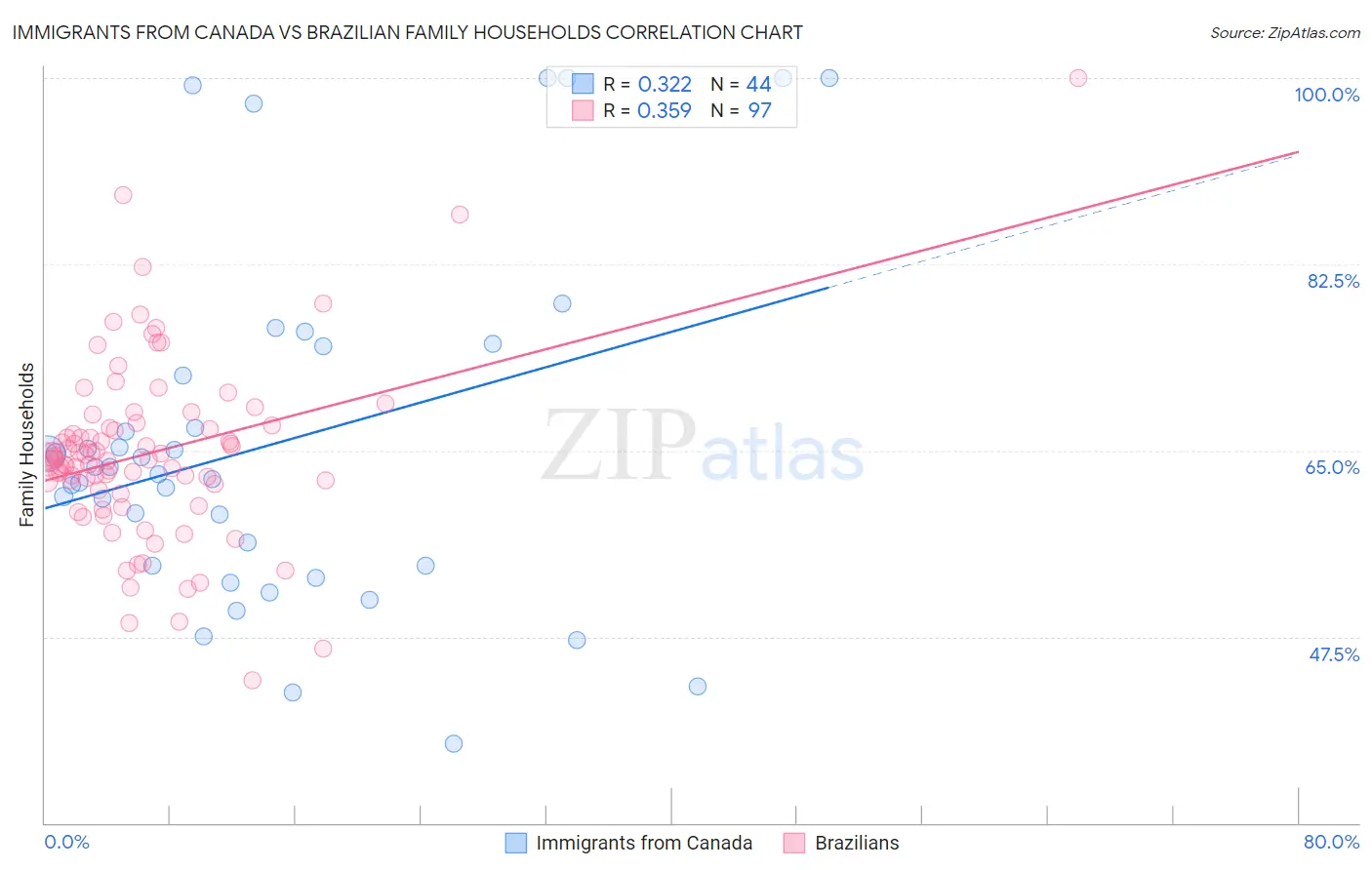Immigrants from Canada vs Brazilian Family Households
COMPARE
Immigrants from Canada
Brazilian
Family Households
Family Households Comparison
Immigrants from Canada
Brazilians
64.0%
FAMILY HOUSEHOLDS
19.2/ 100
METRIC RATING
196th/ 347
METRIC RANK
63.9%
FAMILY HOUSEHOLDS
12.4/ 100
METRIC RATING
205th/ 347
METRIC RANK
Immigrants from Canada vs Brazilian Family Households Correlation Chart
The statistical analysis conducted on geographies consisting of 459,128,452 people shows a mild positive correlation between the proportion of Immigrants from Canada and percentage of family households in the United States with a correlation coefficient (R) of 0.322 and weighted average of 64.0%. Similarly, the statistical analysis conducted on geographies consisting of 323,732,843 people shows a mild positive correlation between the proportion of Brazilians and percentage of family households in the United States with a correlation coefficient (R) of 0.359 and weighted average of 63.9%, a difference of 0.17%.

Family Households Correlation Summary
| Measurement | Immigrants from Canada | Brazilian |
| Minimum | 37.5% | 43.4% |
| Maximum | 100.0% | 100.0% |
| Range | 62.5% | 56.6% |
| Mean | 65.7% | 64.7% |
| Median | 63.1% | 64.2% |
| Interquartile 25% (IQ1) | 54.2% | 61.5% |
| Interquartile 75% (IQ3) | 73.4% | 67.3% |
| Interquartile Range (IQR) | 19.2% | 5.8% |
| Standard Deviation (Sample) | 16.4% | 8.5% |
| Standard Deviation (Population) | 16.2% | 8.4% |
Demographics Similar to Immigrants from Canada and Brazilians by Family Households
In terms of family households, the demographic groups most similar to Immigrants from Canada are Seminole (64.0%, a difference of 0.010%), Polish (64.0%, a difference of 0.010%), Slavic (64.0%, a difference of 0.010%), Immigrants from North America (64.0%, a difference of 0.020%), and Immigrants from Malaysia (64.0%, a difference of 0.030%). Similarly, the demographic groups most similar to Brazilians are Immigrants from Uruguay (63.9%, a difference of 0.010%), Immigrants from Lithuania (63.9%, a difference of 0.010%), Iranian (63.9%, a difference of 0.030%), Norwegian (63.9%, a difference of 0.030%), and Nigerian (63.9%, a difference of 0.030%).
| Demographics | Rating | Rank | Family Households |
| Zimbabweans | 24.7 /100 | #190 | Fair 64.1% |
| Arabs | 24.5 /100 | #191 | Fair 64.1% |
| Lithuanians | 23.8 /100 | #192 | Fair 64.0% |
| French | 23.7 /100 | #193 | Fair 64.0% |
| Paiute | 22.2 /100 | #194 | Fair 64.0% |
| Immigrants | North America | 20.0 /100 | #195 | Poor 64.0% |
| Immigrants | Canada | 19.2 /100 | #196 | Poor 64.0% |
| Seminole | 18.9 /100 | #197 | Poor 64.0% |
| Poles | 18.9 /100 | #198 | Poor 64.0% |
| Slavs | 18.6 /100 | #199 | Poor 64.0% |
| Immigrants | Malaysia | 17.9 /100 | #200 | Poor 64.0% |
| Immigrants | Eastern Europe | 17.2 /100 | #201 | Poor 64.0% |
| Iranians | 13.5 /100 | #202 | Poor 63.9% |
| Norwegians | 13.2 /100 | #203 | Poor 63.9% |
| Immigrants | Uruguay | 12.8 /100 | #204 | Poor 63.9% |
| Brazilians | 12.4 /100 | #205 | Poor 63.9% |
| Immigrants | Lithuania | 12.1 /100 | #206 | Poor 63.9% |
| Nigerians | 11.5 /100 | #207 | Poor 63.9% |
| Immigrants | Bangladesh | 11.4 /100 | #208 | Poor 63.9% |
| Sierra Leoneans | 11.2 /100 | #209 | Poor 63.9% |
| Immigrants | Thailand | 9.6 /100 | #210 | Tragic 63.8% |